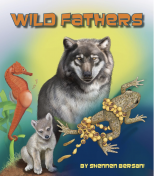
LitPick Review
Animal families come in all shapes and sizes like human families do, but what is so special about certain animal families is that some fathers are an instrumental part of helping hatch and/or raise the offspring. Some fathers are also an integral part of the process to help the female while they wait for their offspring to be born. Within this children’s book, there are thirteen animal fathers that take over important duties for their offspring.
The thirteen animals in this book are the bat-eared fox, the flamingo, the giant water bug, the golden jackal, the golden lion tamarin, the gray wolf, the hardhead catfish, the hellbender salamander, the midwife toad, the rhea, the seahorse, the swan, and the weedy dragon.
Each animal is introduced to the reader, and the educational aspects of what the fathers do to help their offspring be born and thrive in the world are explained.
Opinion:
As an adult, I loved this book because it was written with an educational tone to teach children that there is more to animals than just looking and admiring them in zoos and aquariums. Some of the animals that Shennen Bersani wrote about were animals that I didn't even know existed in the world. For example, the golden lion tamarin is an animal that has orange fur and looks along the lines of a monkey type animal, the rhea is a large flightless bird of South America that looks similar to an ostrich, and weedy dragon is an animal that looks like something in the seahorse family but appears different in decoration of the skin from seahorses. The author thoughtfully compiled her data on the thirteen species I mentioned above and gave wonderful insight into what the fathers do for their offspring before and/or after the birth of their babies. This was definitely a book geared to educate the readers, young and old, while providing fun illustrations to look at as you turn the pages.
The author presented the information to her readers in a way which any child could comprehend what was being taught for each individual animal presented in this book. One example was the gray wolf. While fearsome and protective of their pack, the father not only protects the pack, but hunts food for them to survive. Another example was the bat-eared fox males, who teach the kits to sniff and hunt for their favorite food which is insects. One final example I would like to share are the seahorses. Father seahorses have a pouch where the mother deposits her unfertilized eggs. While in the pouch, the father fertilizes them and controls their salt concentration while providing oxygen and nutrients to the fish that are developing. These are just three of the amazing animals offered in this fun and informational book geared toward children.
The vivid and colorful illustrations, which were also provided by Shennen Bersani, were gorgeous, and the layout of these pictures of each animal species spanned across two pages. I feel that by having such an expansive layout allows the readers to become fully immersed in seeing and learning about the animal species.
The language used throughout this children’s book was definitely educational in nature, but no less fun because it was set out to teach children new fun facts about some fathers in the wild. I felt the language used would be easily understood by the children in the 4-8 year bracket, and while they’re reading, they won’t even know just how much they’re absorbing in learning about animal science.
Overall, Wild Fathers is a book that I feel will appeal to children and adults and is presented in such a fun way that the readers won’t even know just how much they’re learning while they’re turning the pages. Adding this book to your children’s library would be such an educational asset and could be read at any time reading is done with your child. It is well-written and has an enjoyable pacing set throughout. I really enjoyed reading this book, and I highly recommend it!


